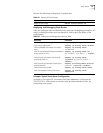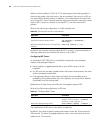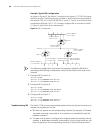
94 CHAPTER 5: IP ROUTING PROTOCOL OPERATION
By default, all interfaces except loopback interfaces both receive and transmit RIP
update packets.
Disabling Host Route
In some cases, the router can receive many host routes from the same segment,
and these routes are of little help in route addressing but consume a lot of
network resources. Routers can be configured to reject host routes by using undo
host-route command.
Perform the following configurations in RIP view.
By default, the router receives the host route.
Enabling RIP-2 Route Aggregation
Route aggregation means that different subnet routes in the same natural
network can be aggregated into one natural mask route for transmission when
they are sent to other outside networks. Route aggregation can be performed to
reduce the routing traffic on the network, as well as to reduce the size of the
routing table.
RIP-1 only sends the routes with natural mask, that is, it always sends routes in the
route aggregation form.
RIP-2 supports subnet mask and classless inter-domain routing. To advertise all the
subnet routes, the route aggregation function of RIP-2 can be disabled.
Perform the following configurations in RIP view.
By default, RIP-2 uses the route aggregation function.
Setting RIP-2 Packet Authentication
RIP-1 does not support packet authentication. However, you can configure packet
authentication on RIP-2 interfaces.
RIP-2 supports two authentication modes:
■ Simple authentication — This mode does not ensure security. The key is not
encrypted and can be seen in a network trace so simple authentication should
not be applied when there are high security requirements
Table 90 Disabling Host Routes
Operation Command
Enable receiving host routes host-route
Disable receiving host routes undo host-route
Table 91 Enabling Route Aggregation
Operation Command
Enable the automatic aggregation function of
RIP-2
summary
Disable the automatic aggregation function of
RIP-2
undo summary


















